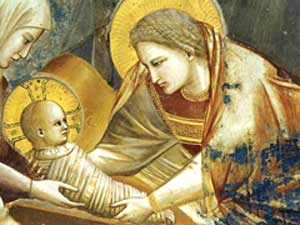Christianity lives within the wonder first
sketched out by the prophet Isaiah and heard in the liturgy throughout these
past weeks of Advent. Lots of Isaiah! Today, as we zoom in on the birth of Jesus
in Bethlehem, we celebrate both the coming of Isaiah’s exalted Lord of Lords
who became a servant, and the birth of Isaiah’s Suffering Servant who became
Lord through his whole life of faithful love of God and neighbor, “even unto
death, death on a cross.”
Although historically birth comes before death,
the early Christians celebrated the death of the Lord long before they came to
ponder his nativity. His Passion and Death are always in the background of the
Infancy Narratives, which were composed last. Looking back from the vantage
point of Golgotha, Matthew and Luke recognized that, from the very first, this
child is born to deal with evil and sin and love gone wrong. Humanly speaking,
he will fail and be buried under the weight of it. Another victim in the bloodthirsty
history of humanity, which continues in our own day.
But the Good News and reason for
celebrating Jesus’ birth is that the whole life ahead of this child will be one
of re-creating our humanity from within our own history. In the stories that
will be told about him, we shall find him restoring and healing, guiding and
welcoming, forgiving and recreating the lives of the ordinary people whom he
meets. So much so, that they will share in his Holy Spirit and become his
co-workers in his mission.
“Re-creating our humanity from within our
own history”— a few days ago I saw an article in the newspaper which struck me
as a powerful example of this, taking place in a “Bethlehem” of our own time,
where there is literally “no room in the inn,” a teeming tent-city in Mexico
where more than 2,500 migrants seeking asylum have squatted while their cases
wind their way through immigration court in Brownsville, Texas. Exposure to the
elements, overcrowding and lack of sanitation have created conditions for
illness to spread in the sprawling camp. The picture that caught my eye, and my
heart, was that of a 28-year-old Cuban critical care physician, the sole doctor
in this tent city and himself also awaiting asylum, treating very sick children
as a peer completely sharing their situation. Under a canopy on the edge of
this squalid encampment he gets right down to their level and all day every day
gives everything of the little he has to treat, stabilize and encourage. A
picture shows him in T-shirt and jeans making a spacer for an inhaler out of a
paper cup to make sure a 4-year-old girl from Honduras who has asthma receives
the appropriate dosage of medication, her eyes looking right into his, and his
into hers as he sprays. He is Christ; she is Christ. Salvation within a shared
history.
At Christmas we ponder, “How did all this
begin?” and “Who is it that is with us still, Emmanuel, even until the end of
time?” In the Gospel, St. John proclaims, “the Word became flesh
and dwelt among us.” To say that this Word “became flesh and
dwelt among us” is to say that God has translated his own character into a
language accessible to us – a lived human life – that of Jesus of Nazareth. Here
the Eternal Mystery of God is showing itself at its most characteristic, though
in a human form. The night before he died, Jesus tells his disciples in the
upper room: “To have seen me is to have seen the Father.” Jesus is the human
face of God. And today’s Gospel concludes with this tremendous claim: “We have
seen his glory: the glory of an only Son coming from the Father, filled with
enduring love.”
Jesus shows us God’s way of being human and
invites us, from his Bethlehem poverty, to follow in his life, to likewise be
“filled with enduring love” (as is that young Cuban doctor on the Mexican
border). Jesus’ truth and faithful love embrace the joy and hope, the grief and
anguish, of the men, women and children of our own time, and as his disciples,
we are to become with him the “in-breaking” of the Reign of God, “the Light
that shines on in darkness.”
That picture in Monday’s paper was, for me,
no less than an icon of “the Light that shines on in darkness,” the Word saving
us within our own context. He does not come to us as some alien from another
world, or even as Isaiah’s “Lord of
Lords and King of kings” intervening from without, but as flesh of our flesh,
making his dwelling among us as one of us – fully human, just as he is fully
divine.
Today, each of us will approach the crèche
and look into the manger. Let us recognize this tiny baby as the Light that
comes in the midst of darkness, our darkness, and believe that this little
child is truly “God-with-us.” Let us honor this tiny Bethlehem that restores
Paradise to us.
Christmas homily by Father Dominic

 The Abbey's cloister garth is a kind of secret garden surrounded by the four cloisters. This garden enclosed is a symbol of the Blessed Virgin Mary, her beauty, and fragrance set apart for Christ alone, a place where he could nestle and grow.
The Abbey's cloister garth is a kind of secret garden surrounded by the four cloisters. This garden enclosed is a symbol of the Blessed Virgin Mary, her beauty, and fragrance set apart for Christ alone, a place where he could nestle and grow.